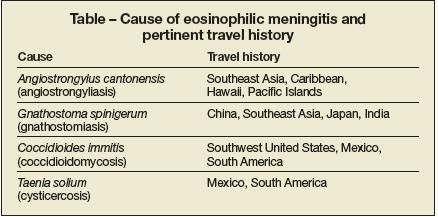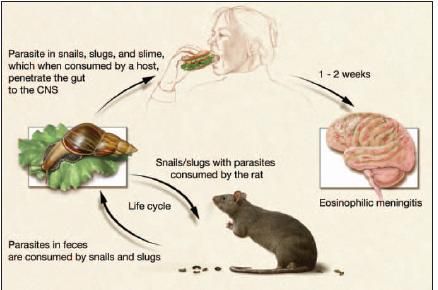Eosinophilic Meningitis Due to Angiostrongylus cantonensis
The case concerns a patient with eosinophilic meningitisattributed to the helminthic parasite Angiostrongyluscantonensis. Before the onset of illness, our patient had ahistory of travel to Hawaii, the only area in the United Stateswhere A cantonensis is endemic. Finding eosinophils in thecerebrospinal fluid (CSF) can narrow the differential diagnosisin a patient with meningitis. In our patient, the proportion ofeosinophils in the CSF was 55%. The case is unique because thepatient was a strict vegetarian. This infection usually developsin persons who inadvertently ingest snails or slugs that containthe parasite. [Infect Med. 2008;25:366-368]
Eosinophilic meningitis is a relatively rare disease, particularly in the United States. It is caused by Angiostrongylus cantonensis and is usually defined as meningitis associated with a cerebrospinal fluid (CSF) pleocytosis of at least 10% eosinophils. The presence of eosinophils in the CSF can be attributed to a variety of infectious and noninfectious causes1; however, observing more than 10% eosinophils in the CSF can significantly narrow the differential diagnosis.
Case report
A previously healthy 26-year-old white woman presented with a 2- week history of severe headache, nausea, and paresthesias. The headache was located primarily in the occipital region and was initially associated with tingling and burning pain in the neck. Over the next few days, the paresthesias moved to her back and extremities as well. She also complained of severe malaise, myalgias, and double vision. She did not report experiencing fevers, rigors, night sweats, photophobia, or neck stiffness. There was no impairment of consciousness.
The patient was healthy and did not take any regular medications. She was born and raised in Phoenix and was a strict vegetarian. A travel history revealed that she had traveled to Hawaii about 3 weeks before presenting to the hospital. Her symptoms had started about a week after her arrival in Hawaii. While there, she worked on a vegetable farm. Her diet mainly consisted of fresh vegetables grown on the farm. She reported seeing snails in the vegetable gardens.
On physical examination, she appeared moderately ill. She was afebrile with normal vital signs. She was awake and oriented, and her neck was supple. Neurological examination found that her pupils were briskly reactive to light, and optic disc margins were sharp on funduscopic examination. There was mild limitation on abduction of both eyes, consistent with bilateral abducens nerve palsy. There were no other neurological deficits. Findings from the remainder of the physical examination were unremarkable.
Initial laboratory studies revealed a total peripheral white blood cell (WBC) count of 13,100/?L, with 62% polymorphonuclear neutrophils, 13% lymphocytes, and 18% eosinophils. A noncontrast CT scan of the head and a subsequent MRI scan of the brain did not reveal any abnormalities. Blood and CSF cultures were negative, including culture for acid-fast bacilli; a stain for acid-fast bacilli also yielded a negative result. Analysis of the CSF demonstrated a glucose level of 4 mg/dL (concurrent serum glucose level, 96 mg/dL) and protein level of 71 mg/dL. The red blood cell count was 2/?L and the WBC count was 340/?L, with a differential of 30% lymphocytes, 12% monocytes, 3% polymorphonuclear cells, and 55% eosinophils. Results of serological tests for Taenia solium and Coccidioides immitis were negative. An infection with Acantonensis was confirmed by serological testing done at the department of helminthology, faculty of tropical medicine, Mahidol University, Bangkok, Thailand.
The patient was treated with prednisone (starting with 40 mg/d and tapered over 2 weeks) and albendazole (200 mg tid for 3 weeks). Despite this therapy, persistent paresthesias and bilateral abducens nerve palsy persisted. The patient was treated with another course of tapering prednisone alone, with slow resolution of symptoms. She recovered completely.
Discussion
Eosinophilic meningitis should be distinguished from the simple finding of eosinophils in CSF. Eosinophilic meningitis is usually associated with a CSF pleocytosis of more than 10% eosinophils1; our patient had 55% eosinophils in her CSF. Relatively few conditions cause a greater than 10% CSF eosinophilia. Some of the principal considerations in the differential diagnosis of eosinophilic meningitis are presented in the Table. In Arizona, the differential diagnosis includes coccidioidomycosis and cysticercosis, which are noted in the Table. Our case highlights the importance of a travel history. The patient's travel to Hawaii, an area where A cantonensis is endemic, raised the index of suspicion for this parasite. In addition, results of tests for T solium and C immitis were negative.

Table
Worldwide, parasitic infections of the CNS are the most common cause of eosinophilic meningitis. In Southeast Asia, Japan, and China, A cantonensis and Gnathostoma spinigerum are the principal causes.2 G spinigerum is not present in the United States; however, eosinophilic meningitis due to A cantonensis is relatively common in Hawaii. There have been a few reports of rats infected with Acantonensis in Puerto Rico and New Orleans, but no reported epidemics. 3 Because Acantonensis is not endemic to Arizona, it would be unlikely for eosinophilic meningitis to occur in a lifelong resident.
The Figure illustrates the life cycle of A cantonensis in rats and snails. Adult worms of A cantonensis live in the pulmonary arteries of rats. The females lay eggs in the terminal branches of the pulmonary arteries. The eggs hatch into larvae that migrate from the lungs into the pharynx where they are swallowed and passed in the rat feces. Feces containing infectious larvae are then consumed by snails or slugs. The parasites develop within these mollusks and are infective to mammalian hosts. When a mollusk containing the parasite is ingested by a rat, the parasite migrates preferentially to the brain and then to the pulmonary arteries to complete the life cycle.

Figure -
Life cycle of Angiostrongylus cantonensis. (Adapted from Guerrant RL et al, eds.Tropical Infectious Diseases: Principles, Pathogens, and Practice. 1999.10 Reprinted withpermission from Elsevier.)
Humans become incidental hosts by ingesting infected snails or slugs. The parasite also migrates preferentially to the CNS, causing eosinophils in the CSF in humans. Because humans are not definitive hosts for A cantonensis, the parasite is unable to complete its life cycle and dies in the CNS. The parasite also can be transmitted by various other creatures, such as crabs and freshwater shrimp, which then act as paratenic (or transport) hosts. They only carry the parasite, which can only resume development if the paratenic host is ingested by a rat or human.
Humans usually become infected with A cantonensis by eating raw or undercooked snails or slugs containing the parasite. Eosinophilic meningitis occurs more frequently in children because they may put a snail or slug in their mouths. However, many patients have no obvious exposure to snails or slugs. Our patient was a strict vegetarian and did not knowingly ingest a snail or slug.
Eosinophilic meningitis has been reported previously in vegetarians.4 In that report, it was postulated that the parasite was in the slime on the vegetation left by migrating snails or slugs. The severity of illness in the patients seemed to be related to the amount of unwashed lettuce they had consumed. In a recent epidemic of eosinophilic meningitis caused by A cantonensis, it was found that patients had consumed raw vegetable juice-supporting the latter epidemiological observation.5
The incubation period of eosinophilic meningitis ranges from a few days to several weeks after ingestion of the parasite. Common symptoms include headache, fever, nuchal rigidity, nausea, and vomiting.6 Neurological complications include paresthesias, radicular pain, weakness, cranial nerve palsies (commonly sixth and fourth nerve), and even coma and death.7 Fatalities do occur, presumably because of large parasite burdens. Paresthesias or hyperesthesias are repeatedly cited in the literature as important to diagnosing this disease.
A definitive diagnosis can be made by recovery of the parasite from CSF or the ocular chamber, but this is a relatively rare occurrence. An MRI scan of the brain may reveal generalized leptomeningeal enhancement or multiple, small, high intensity areas on contrast-enhanced images, presumably representing tissue reactions to dead or dying worms and local vasodilatation.8 We found that serological testing for A cantonensis is not available in the United States. Thus, we sent serological samples to Thailand for confirmatory testing.
Supportive care is generally the only therapy needed. The majority of patients will improve spontaneously. In patients with severe disease who have prolonged headache, repeated lumbar puncture has been performed and corticosteroids have been used for treatment.6 There is controversy about the use of antihelminthic agents; however, results from a recent randomized double-blind study from Thailand suggested that a 2-week course of prednisone (60 mg/d) and mebendazole (10 mg/kg/d) was beneficial in relieving headache in infected patients. 9 Some experts advise against the use of antihelminthic agents because of the possibility of exacerbating neurological symptoms or because of a potential reaction to the parasite dying in the patient's CNS. Albendazole and a corticosteroid were used in our patient without dramatic results; however, she did recover completely.
Eosinophils in the CSF are not common and should raise an index of suspicion for a limited number of causes. The differential diagnosis should be more narrow in a patient with meningitis who experiences paresthesias and has eosinophils in the CSF, as was the case in our patient. Knowledge of Acantonensis, including its life cycle and areas where it is endemic, can help the clinician make a diagnosis in an otherwise difficult patient presentation.
References:
- Kuberski T. Eosinophils in the cerebrospinal fluid. Ann Intern Med. 1979;91:70-75.
- Lo Re V 3rd, Gluckman SJ. Eosinophilic meningitis. Am J Med. 2003;114:217-223.
- Andersen E, Gubler DJ, Sorensen K, Beddard J. First report of Angiostrongylus cantonensis in Puerto Rico. Am J Trop Med Hyg. 1986;35:319- 322.
- Fuller AJ, Munckhof W, Kiers L, et al. Eosinophilic meningitis due to Angiostrongylus cantonensis. West J Med. 1993;159:78-80.
- Tsai HC, Lee SS, Huang CK, et al. Outbreak of eosinophilic meningitis associated with drinking raw vegetable juice in southern Taiwan. Am J Trop Med Hyg. 2004;71:222-226.
- Slom TJ, Cortese MM, Gerber SI, et al. An outbreak of eosinophilic meningitis caused by Angiostrongylus cantonensis in travelers returning from the Caribbean. N Engl J Med. 2002;346:668- 675.
- Kliks MM, Kroenke K, Hardman JM. Eosinophilic radiculomyeloencephalitis: an angiostrongyliasis outbreak in American Samoa related to ingestion of Achatina fulica snails. Am J Trop Med Hyg. 1982;31:1114-1122.
- Jin E, Ma D, Liang Y, et al. MRI findings of eosinophilic meningoencephalitis due to Angiostrongylus cantonensis. Clin Radiol. 2005;60: 242-250.
- Chotmongkol V, Sawadpanitch K, Sawanyawisuth K, et al. Treatment of eosinophilic meningitis with a combination of prednisolone and mebendazole. Am J Trop Med Hyg. 2006;74:1122- 1124.
- Guerrant RL, Walker DH, Weller PF, eds. Tropical Infectious Diseases: Principles, Pathogens, and Practice. Philadelphia: Churchill Livingstone; 1999.